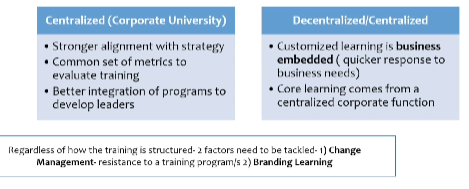MGMT-4153
Exam 1
Chapter 1 Introduction to Employee Training and Development
Objectives
What is training? Why is it important?
Discuss training as a competitive advantage for organizations
Describe the audience and channels for training
Discuss various aspects of the training design process
Describe the amount and types of training occurring in the U.S. companies
What is Training?
Training is a planned effort by a company to facilitate learning of competencies, knowledge, skills and behaviors of employees.
Importance of Training
Equips individuals with necessary knowledge, skills, and abilities (KSA)
Attracts employees to companies, engages them, and promotes retention
Create a competitive advantage
Key Components of Learning
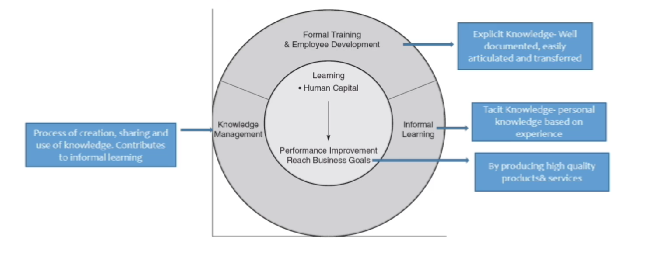 Which Learning is More Important? Formal or Informal?
Which Learning is More Important? Formal or Informal?
While formal training is important, much of what is learned occurs through informal learning
There are several characteristics of informal learning:
Learner initiated
Occurs without a trainer or instructor
Motivated by an intent to develop
Does not occur in a formal learning setting
Breadth, depth, and timing are controlled by the employee
Training vs. Development
Training (Current Job)
Facilitated learning job-related competencies, knowledge, skills or behavior
Development (Future Job/Career)
Future focused—includes formal education, job experiences, relationships, and assessments
A.D.D.I.E for Training Design
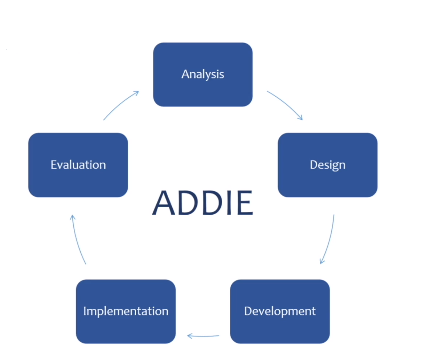
The Training Design Process

Forces that Impact Learning
Economic Cycles
Retiring workforce
Scarcity of Skilled Labor
Retention of Talent
Globalization
Scarcity of talent in emerging markets
Immigrants required to fill high & low-skilled positions
Value of intangible assets and human capital
Human Capital - Competence and knowledge of employees
Intellectual Capital - Patents & copyrights, etc.
Social Capital - Informal networking, coaching/mentoring relationships
Customer Capital - Brands, Customer loyalty, etc.
Focus on links to business strategy
Training aligned to business strategy to achieve strategic goal
Training is an integral part of business success
Training needs - one size does not fit all
Changing demographics and diversity
The median age of the labor force will be 42.3 years in 2026
Between 2016 and 2026, the U.S. labor force will be more ethnically diverse due to immigration
Training helps promote diversity
Generational differences
There are five generations in today’s workforce
Talent Management
Systematic, planned and strategic effort by a company to attract, retain, develop, and motivate highly-skilled talent.
Customer Service and Quality emphasis
Total Quality Management (TQM) - Company-wide effort to continuously improve the way work is done.
Use quality design & effective learning processes & focus on ROI.
New Technology
Value for training added through social media
Enables knowledge sharing/best practices
Created communities of practice
High-performance models of work systems
Employees interact to assemble a product of provide a service
Cross Training - Training of employees in a range of skills to fill different roles
Virtual Teams - Teams separated by time, geographic, and organizational boundaries
Chapter 2: Strategic Training
Learning Objectives
Learning Organization
Learning and Development Strategy
Factors that Influence Learning
Structure of the Training function
Learning or Training Brand
The Learning Organization
A learning organization is characterized as:
A company with an enhanced capacity to learn, adapt, and change
A culture where employees seek, share, and apply new knowledge to improve performance
An organization where training is a part of a larger system to enhance human capital
Human performing companies are more than five times as likely to have a strong learning culture
Strategic Training & Development Process
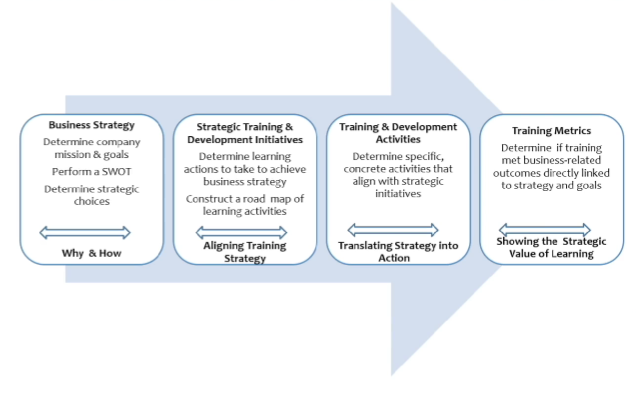 Common Strategic Initiatives
Common Strategic Initiatives
Diversify the learning portfolio
Expand who is trained
Accelerate the pace of learning
Improve customer service
Provide development opportunities and communicate with employees
Capture and share knowledge
Align training with the company’s direction
Ensure the work environment supports learning and transfer
Balanced Score Card
Organizations are using Balanced Score Cards to measure and provide feedback to organizations.
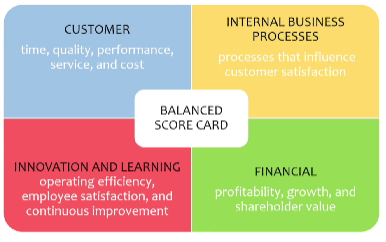 Factors that Influence Training
Factors that Influence Training
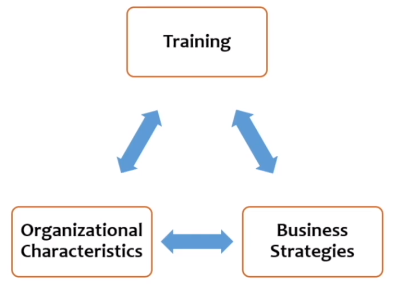 Organizational Characteristics that Influence Training
Organizational Characteristics that Influence Training
Roles of employees and managers
Top management support
Integration of business units
Global presence
Business Conditions
Other HRM practices
Strategic value of jobs and employee uniqueness
Unionization
Staff involvement
Strategic Value and Uniqueness
Knowledge-based workers—heavy training
Job-based employees—less training than knowledge workers
Contract employee—limited training
Alliance/partnerships—sharing expertise and team training
Training for Different Business Strategies
Concentration Strategy
Skill currency and the development of the existing workforce (EX: SW Airlines)
Internal Growth Strategy
Creation of new jobs and tasks, innovation, and talent management (EX: UA & Continental merger)
External Growth Strategy
Integration, redundancy, and restructuring (EX: Amazon & Whole Foods)
Disinvestment Strategy
Efficiency (Ex: Ebay and Paypal)
Training Department Structures
Change Management in Training
Four change-related problems need to be addressed before the implementation of any new training practice
Resistance to change
Loss of Control
Power imbalance
Task redefinition challenges
Branding Training
Despite its value, some individuals may not value training. Therefore, the brand for the training function should be built. Some ways to do that:
Involve target audience
Demonstrate how training can solve business problems
Show examples of previous successes
Identify a champion who supports training
Advertise through multiple channels
Speak in terms employees understand
Chapter 3: Needs Assessment
Learning Objectives
Identify different methods used in needs assessment.
Create conditions to ensure that employees are receptive to training.
Discuss the steps involved in conducting a task analysis.
Explain competency models and the process used to develop them.
The Training Design Process
 Why is the Needs Assessment Important?
Why is the Needs Assessment Important?
Training may not be the solution to a performance problem
Money will be spent on training programs that are unnecessary
Programs may have the wrong content, objectives, or methods
Trainees may be sent to programs for which they do not have the basic skills, prerequisite skills, or confidence to learn
Training will not deliver the expected results
Who should participate?
It is important that all relevant stakeholders be involved.
Different stakeholders bring unique and needed perspectives to the process
Company leaders- helps integrate with business strategy
Mid-level managers- provide budget, determine target audience and jobs that require training
Trainers- align content with business strategy and determine conducive ways to train employees
Employees-diagnose their learning needs for current and future job needs
Subject matter experts (SMEs)- Possess expertise knowledge about the training issue at hand
How Should Data be Collected?
Various methods may be used to collect information. No one method is necessarily superior to another. There are strengths and limitations of each, and each may be more relevant in some contexts than others.
Observation
Survey
Interview
Focus Groups & Crowdsourcing
Documentation
Technology
Historical Data Review
Observation
Advantages
Relevant Data
Minimizes interruption of work
Disadvantages
requires skill in observation
employee behavior may be affected by observation
Survey
Advantages
inexpensive
can collect data from a large number of individuals
data easily summarized
Disadvantages
requires time
potentially low response rates
may lack detail
only provides information directly related to questions asked
Interview
Advantages
good at uncovering detail
can explore unexpected issues
questions can be modified
Disadvantages
time consuming and difficult to schedule
difficult to analyze
need skilled interviewers
can be threatening to SMEs
SMEs may provide socially desirable information
Focus Groups and Crowdsourcing
Advantages
useful for complex or controversial issues
can explore unexpected issues
reduces risk that training will be rejected by stakeholders
Disadvantages
time consuming to organize
group members may only provide socially desirable responses
Documentation
Advantages
good source of information
objective
good source of task information for new jobs and jobs in the process of being created
Disadvantages
may be difficult to understand
potentially obsolete
Technology
Advantages
objective
minimizes work interruption
limited human involvement
Disadvantages
may threaten employees
managers may use data to punish versus train
Historical Data Review
Advantages
provides data related to performance and practices
Disadvantages
data may be inaccurate, incomplete, or not fully reflective of performance
Three Levels of Analysis
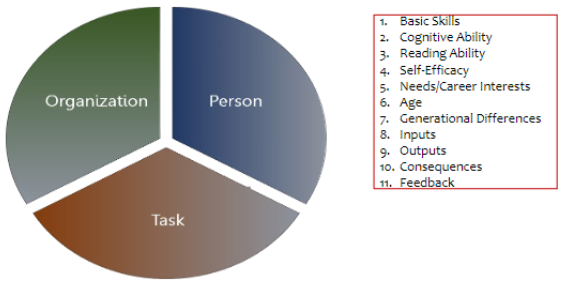 Organization Analysis
Organization Analysis
There are three factors to examine to determine if training is the appropriate solution
The company’s strategic direction
Social support to ensure that individuals are motivated to attend training, learn, and transfer
Training resources, time, and expertise (Buy vs. Build Option)
Strategy → Employee Motivation → Time/Resources
Person Analysis
Helps to identify who needs training
Also known as gap analysis, which involves determining what is responsible for the differences between current and expected performance.
Involves obtaining a variety of information on person characteristics, inputs, outputs, consequences, and feedback.
Gap Analysis → Current State of Performance → Future State of Performance
Person Characteristics
Basic skills: Core skills required to perform successfully on the job
Cognitive Ability: Relates to intellectual capacity and general intelligence- key determinant of training success
Reading Ability: Reading level of the training material should not exceed that required by the job and trainees’ abilities
Self- Efficacy: Trainee’s confidence to learn and apply the training content and perform on the job.
Needs/Career Interests: Creating connections with current job needs/gaps and future career aspirations
Age: Adapting training to meet age barriers. For e.g. mental capacities decrease from age twenty to age seventy
Generational Differences: Training should cater to different generational learning preferences
Inputs: Situational support (equipment, budget etc.) and Social Support (manager and peer willingness to provide feedback and reinforcement) are required
Outputs: Clarity on job performance outcomes
Consequences: Type of rewards that employees receive for performing well. Aligning training to personal/career aspirations
Feedback: Employees need frequent, specific and detailed feedback to influence performance
Is Training the Best Solution?
Is the performance problem important and potentially costly?
Do employees know how to perform effectively?
Can employees demonstrate the correct knowledge or behavior?
Were performance expectations clear?
Were positive consequences offered for good performance?
Did employees receive appropriate feedback?
Were other solutions too expensive or unrealistic?
Perform a root cause analysis
Task Analysis - KSAO
Results in a description of the tasks to be performed and the knowledge, skills and abilities required to perform
Other requirements include conditions under which tasks are performed
To complete a task, employees must possess the necessary KSAOs.
Task Analysis Steps
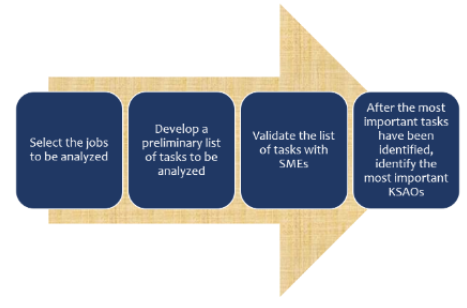 Competency Models
Competency Models
A competency model identifies the competencies necessary for a given job
They provide descriptions of competencies that are common for an entire occupation, organization, job family, or specific job
They are useful for variety of HR practices, including recruiting, selection, and training and development
Developing a Competency Model
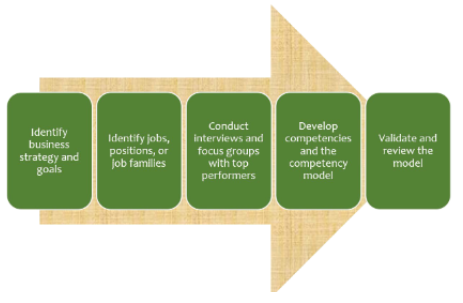 Scope of Needs Assessment
Scope of Needs Assessment
Often managers and trainers may avoid conducting a needs assessment.
They may provide a variety of excuses
Without conducting a proper needs assessment, training will not be well targeted
A needs assessment in practice would not collect all information presented in the text, but should be tailored to the situation at hand.
Due to time constraints, sometimes a rapid needs assessment would be appropriate
A rapid needs assessment refers to a needs assessment that is done quickly and accurately without sacrificing the quality
Basic Skills
Basic skills are those necessary for employees to learn training content and perform successfully on the job
A literacy audit can be used to assess employees’ basic skill levels
Cognitive Ability
Cognitive ability relates to intellectual capacity and general intelligence
Includes verbal comprehension, quantitative ability, and reasoning ability
Assessing cognitive ability is important because it is one of the strongest determinants of training success
Reading Ability
Training material should be evaluated to ensure that its reading level does not exceed that required by the job and trainees’ abilities
If trainees’ reading ability is low:
use other training methods
reassign trainees to different positions
provide remedial training
Self-Efficacy
Self-efficacy relates to trainees’ beliefs that they can master training content and perform on the job
If trainees lack confidence, motivation will suffer
Trainee’s confidence to learn and apply
Enhancing Self-Efficacy
Let trainees know the goal is to improve performance and not reveal incompetence
Providing information about training prior to the program
Describe the success of peers
Emphasize that learning is under trainees’ control
Emphasize that trainees have the ability to overcome obstacles
Preparing and motivating the trainee (Ensuring employee/trainee readiness for learning)
Needs, Career Interests, & Goals
Awareness of training needs, career interests, and goals enhances motivation to learn
The link between training and areas where employees need to improve should be emphasized
Creating connections with current job needs/gaps and future career aspirations
Age
There is biological evidence that certain mental capacities decrease from age twenty to age seventy
However, with age comes experience
Trainers may need to adapt training design and delivery accordingly
Generational Differences
Gen Zs are entrepreneurial and tech-savvy
Millennials are optimistic, embrace technology, and appreciate diversity
Gen Xers need feedback and flexibility and dislike close supervision
Baby Boomers are competitive, hardworking, and concerned with fairness
Traditionalists are patriotic, loyal, and have a great deal of knowledge
Training should cater to different generational learning preferences
Inputs
Inputs relate to resources employees need to help them learn
Situational constraints include lack of tools, equipment, materials, supplies, budgetary support, and time to perform
Social support refers to manager and peer willingness to provide feedback and reinforcement
Outputs
Outputs refer to job performance outcomes
Therefore, it is important to assess employee perceptions of performance expectations
Trainees need to understand the level of expected proficiency
Consequences
Consequences refer to the type of rewards that employees receive for performing well
If employees do not believe rewards are adequate, motivation will suffer
Motivation to learn can be enhanced by communicating the job, personal, and career benefits of learning
Feedback
Feedback refers to the information that employees receive
Employees need specific and detailed feedback
Feedback also needs to be frequent to influence performance
Chapter 4: Learning and Transfer of Training
Learning Objectives
Discuss the five types of learner outcomes.
Explain the implications of learning theory for instructional design.
Incorporate adult learning theory into the design of a training program.
Explain the features of instruction and the work environment that are necessary for learning and transfer of training.
The Training Design Process
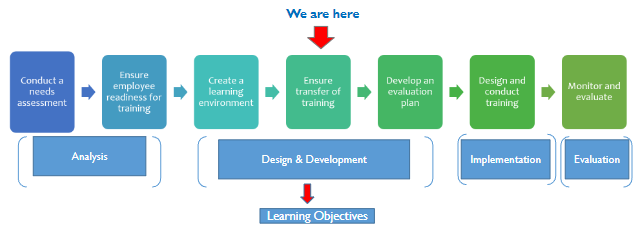 Learning and Transfer
Learning and Transfer
Both learning and transfer are necessary for training effectiveness
Learning: Relatively permanent change in human capabilities
Transfer: Trainees applying what they have learned to their jobs
Generalization: Applying what was learned to situations that are similar but not identical to those in training
Maintenance: Continued use of what was learned over time
Multiple Learning Outcomes
Verbal Information: Specialized and bodies of knowledge (i.e. name the first 3 U.S. Presidents)
Intellectual Skills: Concepts and rules critical to solve problems (i.e. design and code a computer program to track customer complaints)
Motor Skills: Coordination of physical movements (i.e. workout on a treadmill for 30 minutes three times a week)
Attitudes: Beliefs and feelings that makes a person to behave in a certain way (i.e. respond to all incoming mails within 24 hours
Cognitive Strategies: Strategies that regulate thinking and learning (i.e. use three different strategies to analyze stock volatility)
Learning Theories
Reinforcement Theory - Repeating or avoiding a behavior
Individuals are motivated to perform or avoid behaviors because of past outcomes of behavior
Trainers need to identify what outcomes learners find most positive and negative and then link these outcomes to acquiring new knowledge and skills
Implications of Training: Behavior modification is critical to training and is based on reinforcement
Different Types of Reinforcements
Positive Reinforcement: Desirable outcome → Desirable behavior
Negative Reinforcement: Removing an unpleasant outcome (increasing a frequency of a behavior)
Punishment: Undesirable behavior → unpleasant outcome (decreasing a frequency of a behavior)
Extinction: Eliminating a behavior
Social Learning Theory - Learning from others
Individuals learn by observing models of behavior, emulating behavior, and receiving reinforcement and rewards
Learning results from directly experiencing the consequences of using a skill, observing others, and seeing the consequences of their behavior
Process of Social Learning Theory
Attention to aspects of performance
Retention of skills or behavior
Motor (physical) reproduction of skills or behavior
Motivational processes — repeating behaviors that are reinforced
Implications for Training: While choosing training methods, include videos to model desirable behavior
Self-efficacy is Critical
Self-efficacy reflects an individual’s belief that he/she can successfully learn knowledge and skills
Self-efficacy can be increased through:
Verbal persuasion - words of encouragement
Logical verification - relationship between a new and old task
Modeling skills - taught by someone who has mastered it
Past accomplishments - placing in situations where employees are known to succeed
Goal Setting Theory
Behavior is a result of a person’s committed goals (challenging goals result in better performance
Goal Orientation: Goals held by a trainee in a learning situation
Learning orientation relates to trying to increase ability and competence in a task. People with a learning orientation view mistakes as useful for learning
Performance orientation refers to a desire to look good in comparison to others. Individuals with a performance orientation avoid mistakes because they do not want to appear foolish
Implications for Training: While designing programs include goals and objectives
Need Theories
Both Abraham Maslow and Clayton Alderfer believed in hierarchy of needs - key difference is that Alderfer stated if higher level needs are not met employees may refocus on lower level needs
David McClelland focused on achievement, affiliation and power
Implications for Training: If certain basic needs are not met, motivation may suffer
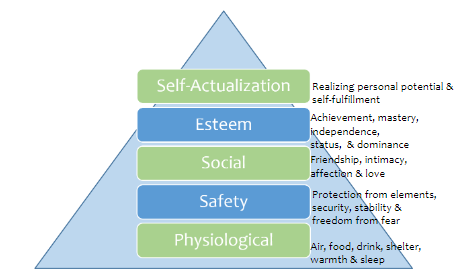
Expectancy Theory - Value placed on outcome
 Implications for Training: Learning occurs when trainees value the outcomes
Implications for Training: Learning occurs when trainees value the outcomes
Adult Learning Theory
Adults have the need to know “why”
Adults have a need to be self-directed
Adults bring more work-related experiences to the learning situation
Adults enter a learning experience with a problem-centered approach
Adults are extrinsically and intrinsically motivated
Implications for Training: Problem centered approach & immediate application of content
Information Processing Theory
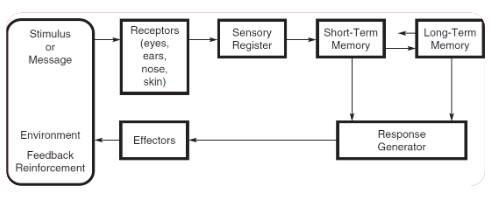 Implications for Training: Internal processes that occurs control the learning & retention of training content
Implications for Training: Internal processes that occurs control the learning & retention of training content
Transfer of Training Theory
Transfer can be enhanced by understanding the type of skill
Closed Skills
Involve responding to predictable situations with standardized responses
Open Skills
Involve responding to variable situations with adaptive responses
Theory of Identical Elements
Transfer will be maximized when the tasks, materials, and equipment in training are similar to the work environment
Identical elements are particularly important for promoting near transfer, applying learned capabilities exactly to the work situation
Stimulus Generalization Approach
Transfer is enhanced when the most important features, or general principles, are emphasized during training
The stimulus generalization approach is appropriate to promote far transfer, applying learned capabilities to the work environment when it is not identical to training
Cognitive Theory of Transfer
Transfer depends on a trainee’s ability to retrieve capabilities (based on information processing theory)
Meaningful material and coding scheme enhance storage and recall of training
Implications for Training: Content includes working on a business challenge & discuss potential application of training content
Mental & Physical Processes
Learning depends on the learner’s cognitive processes, organizing the content in a mental representation, and relating the content to existing knowledge from long-term memory

Learning Strategies
Different learning strategies influence how training content is coded
Rehearsal - learning through repetition
Organization - finding similarities and themes
Elaboration - relating the material to other more familiar knowledge
The Learning Cycle
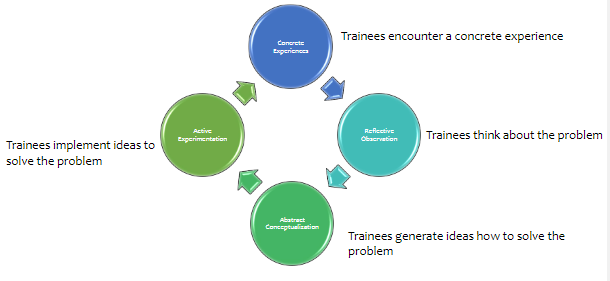
The Learning Styles
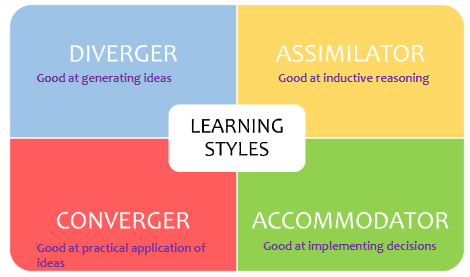
Features of Good Instruction
Employees need to know the objectives
Employees need meaningful training content
Employees need opportunities to practice
Employees need a number of pre-practice conditions
Employees need practice involving experience
Massed vs. spaced practice
Whole vs. part practice
Effective practice conditions
Employees Need to Commit Training Content to Memory
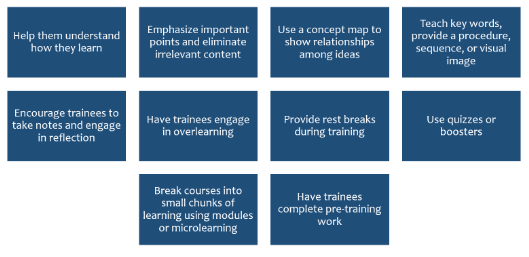
Characteristics for a Positive Climate for Learning and Transfer of Training
Employees need feedback
Employees learn through observation, experience, and interaction
Employees need the training program to be properly coordinated and arranged
Encourage trainee responsibility and self-management
Ensure that the work environment supports learning and transfer
Appendix
Promoting a Learning orientation

Alderfer’s Theory
Existence
physical needs such as food, clothing , and shelter
Relatedness
interpersonal needs in personal and professional settings
Growth
needs for personal development
McClelland’s Theory
Need for achievement
need to achieve challenging goals, prove something, and recognition
Need for power
need to dominate and influence others
Need for affiliation
need to be a part of something and desire for social relationships
Needs Theory Implications
Trainers should attempt to understand learners’ needs, explain how training will meet needs, and adapt training
If certain basic needs are not met, motivation may suffer
However, training should not necessarily attempt to meet all needs
Adult Learning Theory Implications
Mutual planning and collaboration
Use learner experiences for examples and applications
Develop instruction based on learners’ interests and competencies
Provide opportunities for application
Ensure training is problem centered
Information Processing Theory
Information processing theory proposes that information taken in by the learner undergoes several transformations in the brain
A message is received by the senses, is registered, stored in short-term memory, transformed to long-term memory, and a response to the message is organized
The final link in the model is feedback from the environment
Promoting Transfer for Closed Skills
Provide detailed checklists to follow
Provide high-fidelity practice
Shape favorable attitudes toward compliance
Reward compliance
Promoting Transfer for Open Skills
Teach general principles
Shape favorable attitudes toward experimentation
Allow trainees to make mistakes without fear of punishment
Provide rewards for experimentation
Employees Need to Know The Objectives
An objective may have three components
What the learner is expected to do or know
Quality or level of acceptable performance
Conditions under which the learner is expected to perform
Employees need Meaningful Content
Content should be linked to current job experiences and tasks that have meaning
Material should be presented using familiar concepts, terms, and examples
Content should be aligned with personal and professional goals
Employees Need Opportunities to Practice
Practice should:
involve the trainee actively
include overlearning
take the appropriate amount of time
include the appropriate unit of learning
Employees Need a Number of Pre-Practice Conditions
Provide strategies that will result in the greatest learning
Encourage trainees to reflect
Provide advanced organizers
Help trainees set challenging learning goals
Create realistic expectations for trainees
For training in teams, clarify roles and responsibilities
Employees Need Practice Involving Experience
Learners need practice involving direct experience
Over learning is needed
Incorporate errors in the learning process
… and teach individuals how to learn from them
Massed vs. Spaced Practice
Massed practice involves practicing continuously without rest, with spaced practice individuals are given rest intervals within the practice session
In general, spaced practice is superior
Whole vs. Part Practice
Whole practice involves focusing on all tasks at the same time
Part practice involves practicing each component as soon as it is introduced in training
Trainers should incorporate both types
Boosters
Boosters refer to retrieval opportunities that help the learner’s brain consider training information as important and help retain it
Boosters can include short multiple choice, short-answer quizzes, or other activites that require learners to retrieve what they have learned from long-term memory
Microlearning
Microlearning refers to training delivered in small pieces or chunks to engage trainees, motivate them to learn, and help facilitate retention
Chunks of learning are presented using videos or games spanning 5 to 8 minutes
Used to replace longer training and to supplement formal training
Employees Need Feedback
Feedback should be specific and should follow the behavior as closely as possible
Feedback can come from a variety of sources, such as through interpersonal interactions, video recordings, tests and quizzes, on-the-job observation, and performance data
Employee Learn Through Observation, Experience, and Interaction
Individuals learn through observation and imitating the actions of models
Trainers should promote three key types of interaction:
Learner-content - task completed alone
Learner-instructor - interaction between the learner and the expert (trainer) - best for in-depth topics
Learner-learner - task completed in a group
Employees Need The Training Program to be Properly Coordinated and Arranged
Training administration is important
Communicate courses to employees
Prepare instructional materials
Arrange the training facility and room
Test equipment that will be used
Provide support during instruction
Distribute evaluation materials
Encourage Trainee Responsibility and Self-management
Self-management refers to a person’s attempt to control aspects of decision making and behavior
Self-management training involves setting goals to use skills on the job, identifying obstacles and ways to overcome them, and self-administering rewards
Ensure a Supportive Work Environment
Characteristics of a positive climate for transfer include:
Supervisors and coworkers encourage transfer
task cues to use new skills
Lack of punishment for using new skills
Extrinsic reinforcement consequences
Intrinsic reinforcement consequences
Consider Both Internal and External Conditions
Internal conditions are processes within the learner that are necessary for learning
External conditions are processes in the learning environment that are necessary for learning
External conditions should directly influence forms of instruction, and they should be designed to facilitate the internal conditions
Exam 2
Chapter 5 - Program Design
Objectives
Explain the program design elements.
Prepare for instruction using a curriculum road map, lesson plan, design document, and concept map.
Make recommendations about what managers can do before, during, and after training to facilitate learning and transfer.
Identify different ways to manage knowledge and the conditions necessary for employees to share knowledge.
The Training Design Process
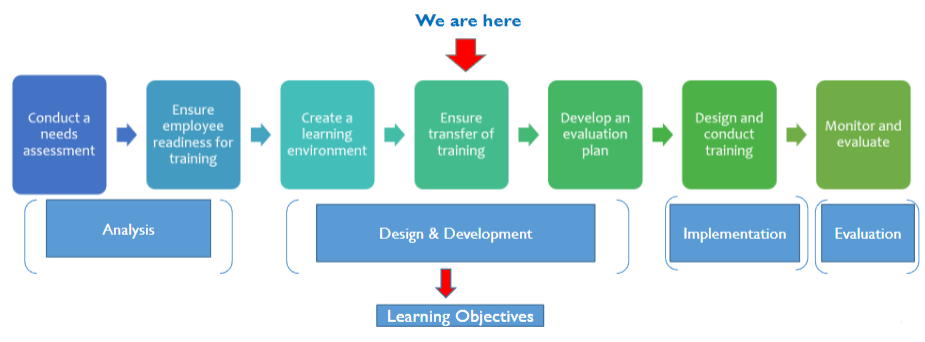
The Importance of Program Design
Program design refers to the organization and coordination of training
Program design is the heart of effective training because it directly influences knowledge and skill acquisition
Programs must be carefully designed to ensure maximum learning
The Program Design Process
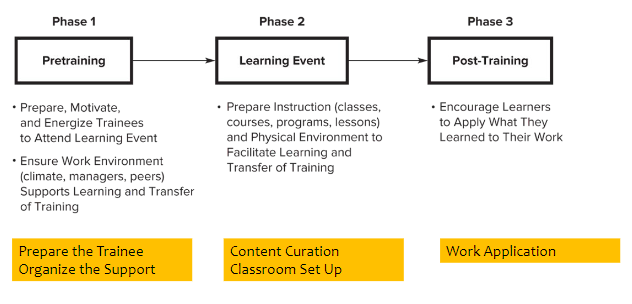
The Training Room
Create an environment conducive to learning—there are a number of details to consider
Noise
Colors
Room Structure
Lighting
Wall & floor covering
Chairs
Glare
Ceiling
Electrical outlets
Acoustics
Technology
Types of Classroom Seating
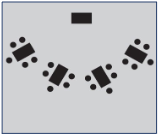 Fan-Type: Trainees can easily switch from listening to practicing in groups.
Fan-Type: Trainees can easily switch from listening to practicing in groups.
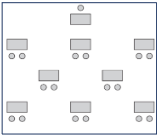 Classroom-Type: Appropriate when lecture and audiovisual presentations are the primary methods.
Classroom-Type: Appropriate when lecture and audiovisual presentations are the primary methods.
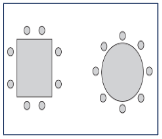 Conference-Type: Appropriate for total group discussions.
Conference-Type: Appropriate for total group discussions.
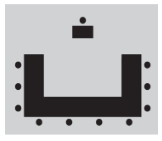 Horseshoe-Type: Appropriate for both presentation and total group instruction.
Horseshoe-Type: Appropriate for both presentation and total group instruction.
Choosing Trainers
Trainers need to be both skilled in the subject matter at hand and in program facilitation
Given that trainers are central to learning experience, great care should be taken when selecting outside vendors
Preparation of Materials
Know content very well
Use mental and physical rehearsal to build your confidence and assess your strengths and areas for improvement
Observe master trainers to get new ideas
Design the training from the audience’s perspective—ask “So what?”
